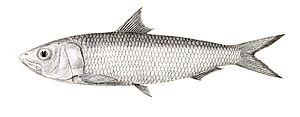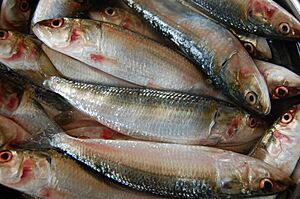Indian oil sardine facts for kids
Quick facts for kids Indian oil sardine |
|
|---|---|
 |
|
| Scientific classification |
The Indian oil sardine (Sardinella longiceps) is a type of ray-finned fish from the Sardinella family. It's one of the most important fish caught for food in India, right up there with the mackerel. You can find these sardines in the northern parts of the Indian Ocean. They love to eat tiny plants called phytoplankton (like diatoms) and small animals called zooplankton (like copepods).
What Does It Look Like?
These sardines have a long, somewhat round body. Their belly is a bit rounded. They have eight rays on their pelvic fins. They also have many gill rakers, which help them filter food from the water. Look closely, and you might see a faint golden spot behind their gill opening. They also have a light golden line along their side and a black spot on the back edge of their gill covers.
Growing Up: Life Cycle of the Sardine
Indian oil sardines become ready to have babies when they are about 15 centimeters long and around one year old. They usually live for about 2.5 years. It's tricky to tell their exact age because the rings on their scales, which are like tree rings, don't always form yearly. Sometimes, these rings appear because they eat less when the water gets warmer in summer.
Scientists have studied their scales to figure out their age. On average, they are about 14.3 cm long at one year old. By two years, they reach about 16.4 cm, and at three years, they are around 18.4 cm long.
Reproduction
The Indian oil sardine's movement and when they lay eggs depend on the water conditions. This means their spawning season can change, happening anytime between June and December. These fish usually lay eggs only once during a spawning season.
Older, more mature adult fish, usually between 17 and 19 cm long, lay their eggs earlier in the season. Younger sardines join in later. The best time for fishing them is often June and July. This is when the younger fish have eaten a lot and are getting ready to lay eggs for the first time. It's rare for an Indian oil sardine to survive and lay eggs a second time, but it happens more often with females.
Female sardines can produce about 75,000 eggs in one spawning season. The eggs develop very quickly, in just about 24 hours. These eggs are round and small, ranging from 1 to 4 millimeters wide. They are called "oil sardines" because their eggs have a large oil globule inside the yolk.
When the eggs hatch, the baby fish are called larvae. On their first day, they don't move much, but they can swim in a wavy motion. The oil globule in their yolk disappears by the end of the first day. By the second day, the larva's colors are set, and its eyes become a shiny silvery white. On the third day, all the yolk is used up.


